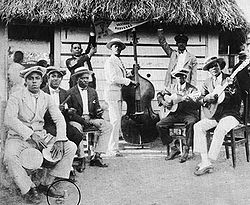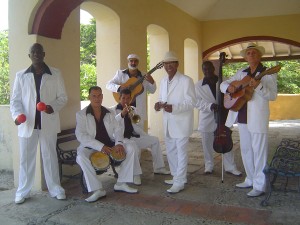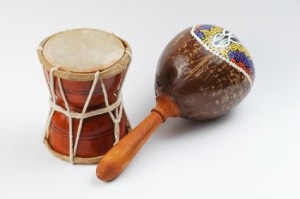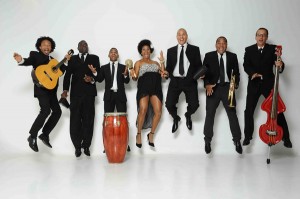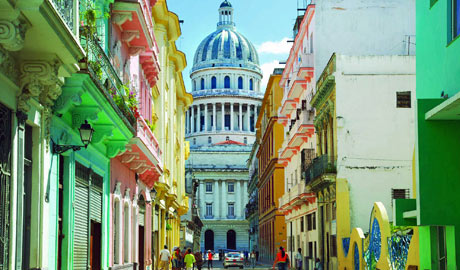THE CUBAN MUSIC History: The “SON”
Gender vocal, instrumental dance, which is one of the basic ways in Cuban music.
Presents in its structure, elements from African music (Bantu) and Spanish, but it fades in Cuban rhythmic twists converge in l, choruses, percussive modes, intonations and sounds of plucked strings denouncing his two original sources.
It is danced by couples bound, and to produce their music is used a wide range of instruments that can be a simple three or guitar, sometimes accompanied by marimbuela, guiro and bongos, to large and complex groups.
According Odilio Urfé the sound is the exponent are more syncretic national cultural identity […] their existence verified concretely begins in the late nineteenth century, in a location comprising multiple zonal montuneros suburbs of eastern cities, like Guantanamo (with Changüí), Baracoa (where according Sindo Garay, originated the Cuban tres), Manzanillo (with organ building its base) and Santiago de Cuba with their neighborhoods folk sub-urban sites
For extraction, development, choreography and sound characteristics and social use, Cuban became historically as the most suitable means of expression and for layers humble representative of the socio-economic-Cuba policy of the first post-war
The complex of Cuban son triumphantly transited the Caribbean, Latin America, North America, Europe and other areas of the world.
The Eastern are moved to Havana on 1909 led to the capital by soldiers of the standing army, in a process of acculturation that determines entry into eastern rumba. Gender mainstreaming at danzoneras orchestras, to compose Jose Urfe, in 1910, his danzón The bowler Barreto, adding a reason for their part are final, and the emergence of the legendary Habanero sextet in 1920, and later National Septet, gave rise to huge Cuban son
Initially danced accessory, solar and dance academies popular layered – rejected bourgeois strata and the government reached prohibit considering it immoral – the dance halls of Havana, and major cities, had to open their doors, and disc printers houses gave one anycast.
Authors Welcome classics of the genre as Julian Gutierrez, Ignacio Piñeiro and Arsenio Rodriguez, and performers such as trumpeter Felix Capotín and great singer Benny Moré, are important figures in the progressive development covering almost all strata and Cuban musical influences-influ- in no small part to the production of various parts of the world. ”
On the structure are Eliseo Grenet wrote, “is the repetition of a chorus of no more than four measures originally called montuno, sung in chorus, and a source of contrast for a voice that not only single pass of the eight “.
Groups are initially consisted of guitar, tres, bongos, jug or marimbuela (later on), claves and maracas, then added one – or more – trumpets.
http://youtu.be/Ew-7ZH14LsM
Currently the format to interpret the genre is unlimited.
The numerous variants are met, some almost independent personality. Urfé mentions:
“El son montuno;el changüí; el sucu-sucu; el ñongo;la regina; son de los permanentes; la bachata oriental; el son habanero; la guajira son; la guaracha son; el bolero son; el pregón son; el son guaguancó; el mambo; y el chachachá.”
The Cuban son is usually located within the resort area sonero of the Caribbean Sea.
In its analysis of key aspects of the genre tell us Rosendo Ruz, son and Vicente González Rubiera, Guyún: “One of the fundamental features that define the character of the Cuban son, occurs in the singular distribution of different stripes or lines that compose timbral its complex rhythmic-harmonic percusional, determining in an unparalleled ensemble polyrhythms.
By examination of old writings and musical sounds based on the listening experience, it can be said that they are (already in its classic form, evolved, as interpreted septetos sextets and the capital Havana to the twenties) has three stripes clearly defined by the ring design percusional and characteristic rhythmic-harmonic (executed in pizzicato bass and guitar with typical scratch – rasgueado semipercutido are, of course, percussion instruments, but they add to the complex percusional based on the way executes the sonero).
Through a consistent design executed by the pizzicato bass setting the rhythmic-harmonic basis are. It is anticipated the call under (syncopated) and summarizes the essence of the original rhythmic and expressive are expressed in bungas oriental oriental sniping groups are composed of a three, guitar and singing.
While the three dots his motives, the guitar holds invariably a companion in a striped pattern (strum semipercutido) that beat of 2/4 musical values corresponds to two groups of four sixteenth.
The attack of this carries a unique striped accents shift that only those who know the genre dominated thoroughly.
The maracas and bongo double rhythmically identical configuration to the guitar.
The key module presents rhythmic bicompasado design.
In the rhythm of two quarters, the first bar (strong) is occupied by the so-called Cuban triplet “, while the second bar (weak) is integrated into eighth note-eighth-eighth-eighth rest.
In summary it can be said that in the complex are instrumental (sextet or septet) evidenced a constant and three stripes contrasting rhythmic juxtaposition of independent dynamic projection.
The first line (syncopated) occurs in the low anticipated.
The second integration time to a companion guitar, maracas and bongos (the latter in the first part are, as in the chorus leaves his bongos steadily-hammer-and moves in free rhythmic variations and improvisations) .
Both bands already mentioned are conditioned and subjected to metric module bicompasado the key touch. “(Op. cit.)
The presence of this Cuban genre is important- and growing – in universal scale within the musical expressions, more authentic and valuable today.
CubanMusic/HelioOrovio/youtube/InternetPhotos/www.thecubanhistory.com
The Cuban History, HOLLYWOOD.
Arnoldo Varona, Editor.
HISTORIA DE LA MUSICA CUBANA: “EL SON”.
Género vocal, instrumental bailable, que constituye una de las formas básicas dentro de la música cubana.
Presenta en su estructura, elementos procedentes de las músicas africanas (Bantú) y españolas, pero ya fundidos en lo cubano, confluyendo en l giros rítmicos, estribillos, modos percutivos, entonaciones y sonoridades de las cuerdas pulsadas que denuncian sus dos fuentes originarias.
Se baila por pareja enlazada, y para producir su música se emplea una amplia gama instrumental que puede ir de un simple tres o guitarra, a veces acompañado de marimbuela, güiro y bongó, hasta grupos más grandes y complejo.
Según Odilio Urfé el son es el exponente sonoro más sincrético de la identidad cultural nacional […] su existencia verificada comienza concretamente en las postrimerías del siglo XIX, en una ubicación zonal múltiple que comprende los suburbios montuneros de algunas ciudades orientales, como Guantánamo (con el Changüí), Baracoa (lugar donde según Sindo Garay, se originó el tres cubano), Manzanillo (con su base organera) y Santiago de Cuba con sus barrios folklóricos de emplazamientos sub-urbanos
Por su extracción, desarrollo, características sonoras y coreográficas y su uso social, el son cubano devino históricamente como el medio de expresión más idóneo y representativo para las capas humildes de la estructura socio-económica-política de la Cuba de la primera post-guerra
El complejo del son cubano transitó triunfalmente por el Caribe, América Latina, Norteamérica, Europa y otras reas del mundo.
El son se trasladó de Oriente a la Habana sobre 1909 llevado a la capital por los soldados del Ejército Permanente, en un proceso de transculturación que determina la entrada en la región oriental de la rumba. La incorporación del género a las orquestas danzoneras, al componer José Urfé, en 1910, su danzón El bombín de Barreto, adicionándole un motivo de son a su parte final, y el surgimiento del legendario Sexteto Habanero, en 1920, y posteriormente Septeto Nacional, le dieron enorme auge al son cubano.
Bailado inicialmente en accesorias, solares y academias de baile por capas populares – los estratos burgueses lo rechazaron y el gobierno llegó a prohibirlo por considerarlo inmoral – los salones de baile de La Habana, y de las ciudades importantes, tuvieron que abrirle sus puertas, y las casas impresoras de discos le dieron una difusión ilimitada.
Autores clásicos del género como Bienvenido Julián Gutiérrez, Ignacio Piñeiro y Arsenio Rodríguez, e interpretes como el trompetista Félix Capotín y el genial cantante Benny Moré, son figuras determinantes en un desarrollo progresivo que abarcó casi todos los estratos musicales cubanos y que influí -influye- en no poca de la producción de diversas zonas del mundo “.
Sobre la estructura del son escribió Eliseo Grenet : “consiste en la repetición de un estribillo de no mas de cuatro compases originalmente llamado montuno, que se canta a coro, y un motivo de contraste para una voz a solo que no sola pasar de los ochos “.
Inicialmente los grupos de son estaban formados por guitarra, tres, bongó, botija o marimbuela (luego bajo), claves y maracas; después se le agregó una – o ms – trompetas.
http://youtu.be/Ew-7ZH14LsM
Actualmente el formato para interpretar el género es ilimitado.
El son ha reunido numerosas variantes, algunas con personalidad casi independiente. Urfé menciona:
“El son montuno;el changüí; el sucu-sucu; el ñongo;la regina; son de los permanentes; la bachata oriental; el son habanero; la guajira son; la guaracha son; el bolero son; el pregón son; el son guaguancó; el mambo; y el chachachá.”
El son cubano suele ser ubicado dentro del complejo sonero del rea del Mar Caribe.
En su análisis de aspectos esenciales del género nos dicen Rosendo Ruz, hijo y Vicente González Rubiera, Guyún : “Una de las características fundamentales que definen el carácter del son cubano, se da en la singular distribución de las diferentes franjas o líneas tímbricas que componen su complejo percusional y rítmico-armónico, determinando en el conjunto instrumental una sin igual polirritmia.
Mediante examen de los viejos sones musicales escritos y en base a la experiencia auditiva, puede afirmarse que el son ( ya en su forma clásica, evolucionada, tal como lo interpretaban los sextetos y septetos de la capital habanera hacia los años veinte ) presenta tres franjas claramente definidas por su timbre percusional y diseño rítmico-armónico característico ( el contrabajo ejecutado en pizzicato y la guitarra con su típico rayado – rasgueado semipercutido no son, desde luego, instrumentos de percusión, pero se suman al complejo percusional en base a la manera que los ejecuta el sonero ).
Mediante un diseño constante a cargo del contrabajo ejecutado en pizzicato se fija la base rítmico-armónica del son. Constituye el llamado bajo anticipado (sincopado) y resume la esencia rítmica y expresiva del primitivo son oriental expresado en las bungas orientales, paqueos grupos de son integrados por un tres, guitarra y cantantes.
Mientras el tres puntea sus motivos, la guitarra sostiene invariable un patrón acompañante en un rayado (rasgueado semipercutido) que en compas de 2/4 corresponde en valores musicales a dos grupos de cuatro semicorcheas.
El ataque de este rayado conlleva un singular desplazamiento de acentos que solo dominan quienes conocen el género a fondo.
Las maracas y el bongó duplican rítmicamente en idéntica figuración a la guitarra.
El módulo rítmico de la clave presenta un diseño bicompasado.
En compas de 2/4, el primer compas (fuerte) es ocupado por el llamado tresillo cubano”, en tanto que el segundo compas (débil) se integra en silencio de corchea-corchea-corchea-silencio de corchea.
En resumen puede decirse que en el complejo instrumental del son (sexteto o septeto) se evidencia una constante y contrastante yuxtaposición de tres franjas rítmicas independientes en proyección dinámica.
La primera línea (sincopada) se presenta en el bajo anticipado.
La segunda la integra a un tiempo la guitarra acompañante, las maracas y el bongó (este último en la primera parte del son, ya que en el estribillo el bongó abandona su ritmo constante -martillo- y se desplaza en variaciones e improvisaciones rítmicas libres).
Ambas franjas ya referidas se acondicionan y someten al módulo métrico bicompasado del toque de claves. ” (Ob. Cit.)
La presencia de este género cubano es importante – y creciente -, a escala universal, dentro de las expresiones musicales mas auténticas y valiosas de hoy.
CubanMusic/HelioOrovio/youtube/InternetPhotos/www.thecubanhistory.com
The Cuban History, HOLLYWOOD.
Arnoldo Varona, Editor.



